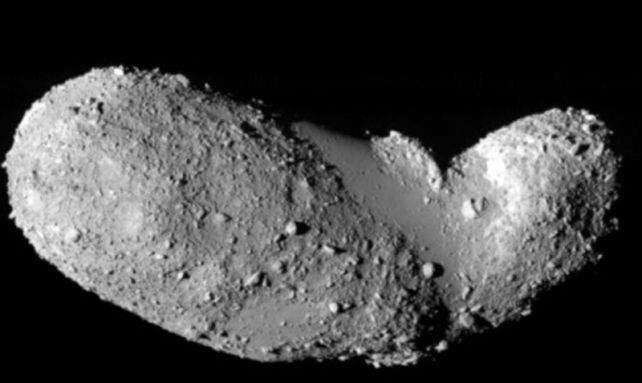An asteroid named for the ancient Egyptian god of darkness and disorder may not pose a hazard to Earth, but that does not mean Earth is not a hazard to it.
When asteroid 99942 Apophis flies closely past Earth in 2029, the gravitational interaction between the two bodies is likely to dramatically alter the asteroid’s surface.
That’s the conclusion of an investigation led by planetary scientist Ronald Ballouz of Johns Hopkins University Applied Physics Laboratory, who believes their findings may offer an explanation for why some asteroids have surfaces younger than their time tumbling through space would indicate.
99942 Apophis is a cheeky one. Upon its discovery in 2004, scientists calculated the the 335-meter (1,100-foot) chunk of rock’s trajectory could potentially bring it onto a collision course with Earth on its approach in April 2029. Gave us a jolly good scare!
Luckily, a scare was all it was. Scientists have crunched and re-crunched the numbers, then crunched them again for good measure. 99942 Apophis will fly by less than 32,000 kilometers (20,000 miles) from Earth in 2029 – but there’s no chance of it hitting our world in the next century.

But what of 99942 Apophis? Is it going to escape unscathed? As Ballouz and his team observed, near-Earth asteroids like 99942 Apophis tend to have two properties. Their surfaces are loose and rubbly; and they seem to show less space-weathering than asteroids that don’t experience planetary flybys.
This is curious. Most asteroids are thought to be made from material that clumped together during the early days of the Solar System, 4.5 billion years ago. Since then, they ought to have been flying around relatively unchanged. It’s why we send probes to take samples from them; their material is thought to represent a repository of pristine material from which the planets were made.
However, even just hanging about in space can wreak changes. The solar wind, solar radiation, and micrometeoroid bombardment conspire to weather surfaces unprotected by an atmosphere; asteroids should be fair game. Ballouz and his team wondered if there might be a connection between the more youthful appearance of near-Earth asteroids and their near-Earth shenanigans.
To find out, they conducted modeling of the 2029 99942 Apophis flyby of Earth. We don’t really know what shape the asteroid has, but what data we have obtained suggest that it is bi-lobed, perhaps a pair of joined objects not unlike the potato-shaped 25143 Itokawa.
So, they took Itokawa as their base model, and tweaked the composition of their model asteroid to see what happens when they throw it past a model Earth. And they found that Earth’s gravity can, indeed, very plausibly have a detectable effect on 99942 Apophis.
The most immediate effect would kick in as the asteroid draws in for its closest approach to Earth. As it whizzes by, the 99942 Apophis would shake in a series of short-term seismic events. These seismic events could be detectable, and produce surface accelerations of magnitudes similar to the asteroid’s gravity.
frameborder=”0″ allow=”accelerometer; autoplay; clipboard-write; encrypted-media; gyroscope; picture-in-picture; web-share” referrerpolicy=”strict-origin-when-cross-origin” allowfullscreen>
The patterns created by lifting and falling boulders should be immediately detectable using Earth-based instruments.
The second effect would be longer-term. As the asteroid nears Earth, the gravitational interaction could change the asteroid’s rotation. Over time, as the asteroid continues to tumble around the Sun with its new spin, the surface could slide around, refreshing itself over tens of thousands of years.
According to a 2010 paper, the maximum asteroid-Earth flyby distance for an altered spin state is 16 Earth radii – around 102,000 kilometers. 99942 Apophis’ flyby distance is predicted to be a lot closer than that, so the possibility of surface alteration is high. We may not be able to test whether that alteration takes place, but we may be able to measure changes to the asteroid’s spin.
We’re honestly pretty amped for the flyby. The asteroid will be visible to the naked eye as it skims past Earth, granting us a rare opportunity, not just to wave at a passing asteroid, but study it in greater, closer detail than we are usually able.
We just hope the mementos the asteroid carries away are fond ones. We don’t want it coming back like an asteroid pugilist, ready to give us what for.
The research, accepted into The Planetary Science Journal, is available on arXiv.





